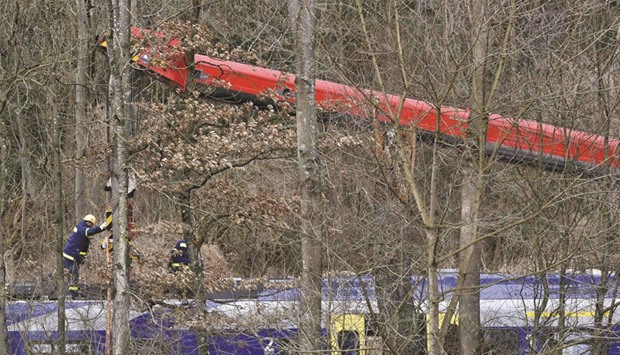German prosecutors and police investigating a head-on train crash in Bavaria that killed ten people are focusing on the actions of a signal controller, a source involved in the inquiry told Reuters yesterday.
However, investigators said it was too early to speculate on the cause and that they have recovered two of three black boxes from the two passenger trains that collided at peak commuter time on Tuesday morning.
“The investigations are focusing on the controller,” said the source, who declined to be named.
The single track stretch was opened for both trains, the source said.
The source did not name the controller.
Reuters was unable to determine the identity of the controller or what actions were under scrutiny.
In addition, Reuters could not determine if other individuals were also under scrutiny.
A spokeswoman at state-run railway, Deutsche Bahn, which is responsible for the track, said the company was working with investigating authorities.
“We do not want to pre-empt the results of the investigation,” she said.
German Transport Minister Alexander Dobrindt, echoing statements from investigators, said that it was too early to identify the cause.
“We have no knowledge whether this was down to human failure or a technical problem,” he said.
Co-operating closely with investigators, salvage workers and criminal police were combing the site yesterday and working to recover the carriages that were lying on their side in the wooded area with a river on one side of the track.
The trains, carrying about 100 people in all, crashed at high speed on a 6km stretch of track between the spa town of Bad Aibling and Kolbermoor, near the Austrian border.
All bodies had been recovered from the wreckage, police said, adding that 17 people were seriously injured and 63 slightly injured in the train collision.
Transport Minister Alexander Dobrindt told rolling news channel NTV that an automatic braking system fitted on the line underwent routine checks just a week ago and was found to be “fully functional”.
The trains and track were fitted with an automatic brake system that was introduced across Germany after 10 people died near the eastern city of Magdeburg in 2011 when a train driver drove through two red signals.
Dobrindt added that one of three black boxes showed there was “no technical problem on the line and that the signal handling of the driver was correct”.
Nevertheless, he said that “one cannot rule out any error”, stressing that data from all three boxes had to be analysed before drawing conclusions.
Two of the three black boxes had been recovered hours after the crash, but investigators were still searching for the third.
“Without the information from this black box, it is impossible to have a complete analysis on whether this was a technical fault or human error, or a combination of both,” he said.
Citing sources close to the investigation, newspaper group RedaktionsNetzwerk Deutschland (RND) said a signal station worker had manually deactivated the automatic signalling system to let the first train – which was running late – go past.
That action would have also shut off the automatic braking system.
The second train then forged ahead on the same track in the opposite direction, before the first was able to split off where the line divides into two, according to RND.
The influential daily Sueddeutsche Zeitung also said preliminary investigations showed a signals controller had switched off the safety system and only realised his colossal mistake when it was too late.
Police would not confirm the reports, and a spokeswoman from the transport ministry would also not be drawn.
“All possibilities that could have led to this disaster are being examined. That includes examining the black boxes, looking at what happened on the tracks, speaking with witnesses and signal workers,” said spokeswoman Vera Moosmayer. “The investigations are ongoing.”

Members of German Federal Agency for Technical Relief work at the site of the two crashed trains near Bad Aibling.


